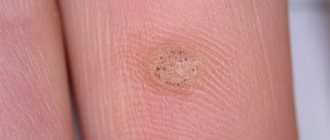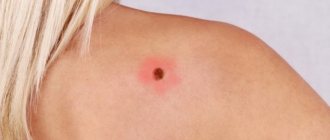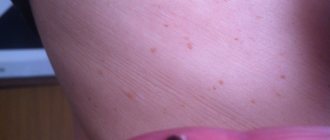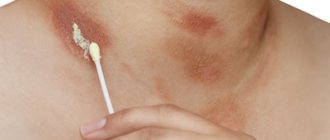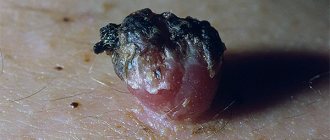Anyone can encounter such a nuisance as a wart. This is one of the most common skin defects. This is due to the viral nature of neoplasms.
READERS RECOMMEND!!!
To treat papillomas, our readers actively use the remedy... Read more
It is even more unpleasant to discover that blood is coming from the wart. This problem terrifies many; they don’t know what to do or who to turn to. Since the causes of bleeding can be different, you should understand the algorithm of actions when such a problem occurs.
Reasons for education
The main cause of all skin growths is infection with papillomavirus. According to statistics, more than 80% of the world's population are carriers of HPV. The high contagiousness (infectiousness) of papillomavirus is the reason for the appearance of skin defects in a large number of people.
How soon after infection the growths appear depends on the level of the body's immune defense. The higher the immunity, the longer the HPV remains in “sleep mode”. Of course, neither a healthy body nor drug therapy can completely cope with papillomavirus. It remains in the body and waits for the weakening of the defenses to begin “active” actions.
Injury to the neoplasm
It is not difficult to damage the growth. Especially if it has a thin “leg” or is located in an open area (neck, back, nose) or in an area where it can be easily cut off with a razor during hygiene procedures.
You can damage a wart if you try to remove it yourself using the wrong method: tweezers, scissors, thread.
During sexual intercourse, you can unintentionally injure a condyloma located on the genitals. The growth near the anus is often damaged during defecation.
Important!
You should not remove a damaged wart yourself. Trauma to the tumor can cause the spread of papillomavirus, the development of a secondary infection, or the onset of malignancy.
Damage to the formation provokes the entry of HPV into the bloodstream and the appearance of daughter defects. The growth of such tumors creates additional discomfort for the patient.
Why does a mole bleed?
According to medical classification, moles are classified as simple nevi (lat. Naevus). This is a benign formation, which is a natural accumulation of the melanin pigment, which gives it its brown color. The number of moles on the body is determined by hereditary factors. Nevi are divided into flat and convex, and can have different sizes and shades (light or dark).
Convex types are most often subject to injury, and many people are very frightened by the situation when blood comes from a mole. There is even an opinion among people that due to damage a malignant tumor may grow. However, research by scientists proves that there is no connection between these facts.
In their opinion, the processes occurring with the mole (changes in shape or color) should cause concern - they may indicate the beginning of the development of oncology. Therefore, you should regularly monitor the condition of such formations, and at the slightest suspicion, contact specialists for help.
Doctors recommend: if a mole is bleeding, then you should take the necessary actions to stop the bleeding, and then monitor its condition.
Injury to nevus
Experts strongly do not recommend touching accumulations of pigments on the body: trying to burn them out, bandage them, or use folk recipes to remove them.
However, often mechanical damage, when blood begins to flow from a mole, occurs for natural and accidental reasons:
- a cut occurred during depilation on the face or elsewhere;
- the nevus was torn off after it caught on clothing (collar, belt, etc.);
- injury from physical activity, such as drying off with a towel after a shower.
The causes of bleeding lie in the very structure of the nevus, which is fed by nearby blood vessels. As a result, when injured, blood can flow quite heavily. Some people can become confused by the fear of bleeding and the inability to stop it. In addition, you can accidentally pick off a mole in a place where it is not visible (on the back, etc.) and not immediately detect the problem.
If the nevus continues to bleed for a long time after removal, then you should consult a doctor.
Pathological causes
The causes of the phenomenon when a mole bleeds for a long time in the absence of mechanical injury may be:
- inflammatory processes in the upper layer of skin;
- malignant formations.
To make an accurate diagnosis, you need to go to an appointment with a dermatologist and do a histological examination of the stripped piece of nevus to detect oncology. But even if it is a benign tumor, experts will definitely recommend its removal. As a result of the operation, the formation is removed, and the collected material is sent for a biopsy to check for malignant cells.
After removing a nevus, it is recommended to follow the following rules:
- regularly disinfect the damaged area, being careful not to tear off the crust;
- use special ointments for tissue regeneration;
- It is forbidden to cover the wound with a bandage or plaster;
- Do not sunbathe until the wound disappears.
Inflammatory process
In an injured neoplasm, infection may develop due to pathogenic microorganisms entering the wound. The wart bleeds due to the inflammatory process. In addition to damage, the inflammatory process is provoked by:
- Squeezing, rubbing the growth;
- Changes in hormonal levels (pregnancy, lactation, adolescence) or taking steroid drugs;
- Emotional or physical stress;
In addition to bleeding, inflammation is accompanied by burning, itching or purulent discharge from the growth. The neoplasm takes on a dark shade, and the epithelium around it swells and turns red.
Methods to stop bleeding and eliminate pimples
What to do if the wart bleeds? In such cases, you should consult a doctor. Independent cutting, burning, or other methods of removing warts, papillomas, and condylomas is strictly prohibited. Any such attempt leads to the development of an inflammatory process on the skin due to the penetration of various bacteria into the wound. In most cases, everything is limited to treating the resulting inflammation.
But sometimes damage to the tumor provokes the development of an oncological complication, the consequences of which can be dangerous for the patient.
How to stop bleeding from a wart, what actions can be done at home? If a pimple is damaged and blood appears, a person should treat the wound with hydrogen peroxide. After this, it is recommended to use some kind of antiseptic. It is not advisable to use iodine or brilliant green for this, as this will subsequently make it difficult for doctors to assess the damage.
After using an antiseptic, it is recommended to use a bactericidal patch, which is applied to the treated area. This will protect the wound from the invasion of pathogenic bacteria.
Some people do not go to the doctor after carrying out all the above measures, believing that everything will go away on its own. But small pieces of pimple may remain in the wound, which will cause inflammation. Therefore, you need to undergo an examination by a doctor, who will then remove the remnants of the wart and completely clean the wound.
If the pimple does not heal for a long time, complete removal of the skin growth may be required. Doctors choose the method of eliminating it after examining the patient. If a danger of tumor growth or the presence of cancer cells is detected, doctors remove the wart surgically. To do this, excision of the surface of the formation with a scalpel is used.
If the pimple has a benign etiology, it is eliminated using laser equipment, acid, liquid nitrogen, or the radio wave method. The safest, painless and effective methods of treatment are considered to be a laser beam and a radio wave method of evaporating the wart structure. They practically do not cause complications and have a short rehabilitation period.
The process of rebirth
The fact that a wart is bleeding may be an alarming “bell” about the onset of malignancy – the transformation of cells into malignant ones.
Important!
Injury or incomplete removal of the growth is the main reason for its degeneration.
The process of malignancy is characterized, in addition to bleeding, by the following symptoms:
- Rapid growth in education;
- Change in color;
- Suppuration and swelling;
- Unpleasant sensations (pain, burning or itching);
The appearance of at least one of the listed signs is a reason to immediately contact a specialist.
The risk of transformation of a neoplasm into a cancerous tumor depends on the strain of papillomavirus that caused its appearance. The greatest danger is represented by condylomas localized on the mucous membranes of the larynx, mouth, and genitals. However, trauma to the growth can lead to degeneration of even benign formations.
Video on topic
Warts are benign formations on the human body that appear as a result of the activation of the papillomavirus. Papillomas can appear in any person. Most often, their appearance indicates a weakened immune system. Hot spots for their distribution: swimming pools, saunas, baths, common household items.
Cutting off a wart is unsafe and risky
As soon as you discover a growth on your body, you need to consult a doctor to find out the nature of the formation and begin treatment in a timely manner, and most importantly not to infect others. Often warts and papillomas are located in places where they are easily injured. Permanent injury can lead to very unpleasant consequences. What happens if you tear off a wart? What measures should be taken if a wart is ripped off? This will be discussed in this article.
What to do if there is bleeding from a wart
Intentional or careless tearing of part of the tumor provokes bleeding. How strong it will be depends on the individual characteristics of the patient, history of diseases and the course of the papillomavirus infection. You need to stop the bleeding that is flowing as soon as possible. Otherwise, this may cause the development of a secondary infection.
If possible, you should immediately seek qualified medical help. But if this is not possible, you need to treat the wound with a three percent solution of hydrogen peroxide. Then you should cauterize the damaged area with an antiseptic. It is not recommended to use brilliant green, iodine, or blue for processing. The coloring enzymes in these solutions may prevent you from noticing the first signs of inflammation or other complications.
A good option for disinfection would be miramistin or chlorhexidine hydrochloride. To protect against pathogenic microflora entering an open wound, you should cover it with a bactericidal plaster. Try to save the torn part of the formation. To do this, you need to place it in a small container and fill it with saline solution. It will be needed if a histological examination is ordered.
Important!
Even if you managed to stop the bleeding and nothing happens to the wound, do not delay visiting a doctor.
The specialist will check for signs of malignancy, remove dead tissue and prescribe effective treatment.
Help needed
Treating wart growths as something harmless often leads to negative consequences. Therefore, you need to know what the phenomenon of wart bleeding means. It must be said that there are few options in this case. A wart bleeds most often if its integrity has been accidentally broken.
The neoplasm is fed by blood from the vessels. That is why damage to its tissues leads to bleeding. It is not difficult to damage this area - sometimes it is quite unfortunate to touch it with a hard object or rub it with clothing. This also happens when the surface of the growth dries out - then it can crack. Then the complaint arises that the wart is bleeding.
Therefore, doing this is strictly prohibited. If a wart bothers you, you should consult a doctor. Due to injury, an infection can enter the wound, under the influence of which the pathological process can spread, or the damaged cells begin to degenerate into malignant ones.
In this case, not only does the wart bleed, but other unpleasant symptoms also appear, such as pain and itching in the area, as well as an increase in size or color of the growth.
It is very important to know what to do if warts bleed. This will avoid possible adverse consequences
The most correct thing to do in such a situation is to consult a doctor. He will perform all the necessary actions and also determine the causes of the problem. But the patient himself can take primary measures to minimize the risk.
The first thing to do when this symptom is detected is to carry out disinfection. Infection of the wound is very dangerous, so you need to treat the surface of the growth with a disinfectant. Hydrogen peroxide is best suited for these purposes.
After this, you need to try to protect the wound from further adverse effects. To do this, you need to use a bactericidal patch. All this should be done after the blood has stopped flowing. This usually occurs when the wound is treated with a disinfectant.
If this does not happen, you first need to stop the bleeding. This is done with hydrogen peroxide, but if this does not help, you can burn it with iodine or brilliant green (in this case, their use is allowed). If there is no effect, you need to apply a patch, then make a tight bandage and immediately go to the doctor. He can figure out how to stop the bleeding.
Types of neoplasms prone to malignancy
Some categories of warts are more prone to degeneration than others. Thus, simple or vulgar growths can be injured if they are localized on the fingers and the back of the hand. Pain syndrome is not typical for such neoplasms, so patients often forget about them. To prevent damage to such growths, you can seal them with adhesive tape. Spikes or plantar growths are susceptible to rubbing with shoes, and condylomas are damaged during sexual contact.
Flat or juvenile neoplasms are least susceptible to trauma. Thanks to their smooth flat surface and small size, they are quite difficult to damage. Their occurrence is due to hormonal changes during adolescence. Therefore, youth education often occurs independently without outside intervention.
What are there
Growths that appear on the skin due to infection with papillomavirus can vary in shape and structure.
Much depends on the specific strain that enters the body. And there are about a hundred of them.
Basically, warts can be classified as follows:
- simple (ordinary) - a dense, sometimes keratinized nodule with a diameter of up to 0.5 cm, which appears on the skin of the hands and fingers; in a child it can also be found on the knees;
- flat - a dense spot with a flat, smooth surface, sometimes irregular in shape, protrudes slightly above the skin, often becomes inflamed and itchy, such growths usually appear in children and adolescents;
- plantar (spike) - a plaque on the foot that is off-white or yellowish in color with a keratinized uneven surface that sometimes cracks; as the wart grows, the pain when walking increases because it grows deep inside;
- filiform - a small growth (from 1 mm), usually on a stalk, papillary in shape, soft but elastic, which usually occurs on thin skin around the eyes, on the neck, under the arms, in the fold under the breast or in the groin;
- genital warts are a type of warts that form on the mucous membrane of the genital organs, mouth, larynx, nose, have several peaks of unequal height, are elastic, and are prone to fusion with newly formed growths.
The type of wart is easy to determine from the photo.
They do not have cavities inside, they are formed directly from epidermal cells, therefore, when pressed, they do not move from their place, representing a single whole with the skin or mucous membrane.
How to Avoid Damage
The most reliable protection for wart growths from injury is timely disposal of them. But if at the first stage of the disease it is not possible to visit a specialist, you should be careful:
- If the tumor is located in the area where you shave your hair, you should carry out this hygienic procedure carefully, using a razor with a soft “floating” head, or even stop shaving for a while;
- Neoplasms that are localized on the limbs or areas of the body that are constantly in contact with clothing should be covered with an adhesive bandage.
Important!
By protecting neoplasms from trauma, you reduce the risk of their malignancy.
Why is it dangerous?
If blood bleeds from the wart, this can lead to suppuration of the wound. Therefore, when blood appears, it is necessary to treat the skin with a disinfectant solution, and also carry out dressings.
In order to speed up the healing process, the damaged papilloma should not be allowed to come into contact with water.
Treatment can be carried out at home only if the damage is minor and the bleeding quickly stops.
If bleeding occurs from the tumor, you should not remove it yourself, as this will lead to increased bleeding and pain. Any manipulations related to the removal of papilloma and warts should be carried out only by a specialist after conducting the necessary examinations. If the bleeding cannot be stopped, seeking medical help will be necessary.
If the growth occurs on the face, foot, or palm, the likelihood of mechanical damage and associated bleeding increases. Therefore, it is better to remove such tumors immediately, without waiting for them to be injured.
In order to avoid damage to papillomas on the back and neck, you need to carefully use washcloths, towels, and be careful when dressing.
You should also be concerned if the papilloma is black in color, quickly increases in size, causes pain when pressed, the inflammatory process increases and cannot be treated with conventional means. All this may be a sign of malignancy and requires immediate consultation with a doctor.
Thus, if there is bleeding from a growth on the skin, contacting a doctor and timely treatment or getting rid of the growth will help to avoid further health problems.
Treatment after healing
Once the bleeding has been stopped and the tumor has completely healed, removal should begin as soon as possible. You can choose a radical method of getting rid of growths in a specialized clinic or medical center, or you can decide on conservative treatment at home.
The following medications are suitable for home use:
- Salipod;
- Super clean;
- Verrucacid;
- Wartner Cryo;
- Collomak;
- Salicylic acid;
- Feresol.
The main thing is to follow the instructions exactly and not allow the product to come into contact with healthy areas of the skin.
Possible complications and precautions
The most terrible complication after damage to a wart is malignancy. The development of squamous cell carcinoma of the cervix against the background of dysplasia is likely. More often characteristic of oncogenic types of the virus, which are found in foci of a malignant tumor.
After a wart injury and a careless attitude towards it, there is a high risk of suppuration. Signs of inflammation appear: the surrounding skin becomes swollen, red, hot, and there is pain. The surface becomes wet, then erosions or ulcers form. They begin to fester and the purulent contents to drain. In such cases, anti-inflammatory therapy is used, treated with antiseptics and the pathological focus is removed.
To prevent damage, you must:
- choose the right shoes;
- do not wear clothes that restrict movement, especially in areas where growths are located;
- do not scratch them until they bleed;
- It is prohibited to remove it yourself at home;
- If there are growths on your hands, when working in the garden, while washing dishes and doing laundry, use personal protective equipment - gloves.
The article has been reviewed by the site editors
Radical removal
The most reliable way to combat a tumor is removal in a specialized medical institution under the supervision of qualified specialists. This method of treatment is the fastest and most effective.
The attending physician will definitely prescribe a comprehensive course of treatment for neoplasms. It includes:
- Direct removal of growths;
- Taking antiviral drugs;
- Preventive actions.
Modern medical centers offer to remove the growth using:
- Laser destruction;
- Radio wave therapy;
- Cryodestruction;
- Electrocoagulation;
- Surgical operation.
All these methods are highly effective, but cannot guarantee that growths will not reappear. This is due to the fact that today there is no cure for papillomavirus. It remains in the human body and waits for the right moment for “active action.”
Therefore, complex therapy for neoplasms includes taking antiviral drugs (Acyclovir, Viferon) and immunostimulants (Interferon, Giferon, Imiquimod).
The main preventive measures are:
- Balanced diet;
- Taking vitamins;
- Elimination of physical and emotional stress;
- Personal hygiene;
- Healthy lifestyle.
All this will help keep you healthy and protect your loved ones from infection.
Venous
It is easy to determine that it is venous blood flowing from the wound. It is dark in color and flows out in a stream. The volume of blood loss and its rate are determined by the caliber of the damaged vessel. The most reliable way to temporarily stop is to use a pressure bandage. Those who want to know how to stop bleeding at home using this method should not worry - everything is quite simple. After treating the wound with an antiseptic, gauze is applied in several layers (cloth, handkerchief), and a roll of cotton wool or bandage is applied to it. It is he who performs the pressing function. Then everything is tightly bandaged. Thus, the edges of the wound together with the vessel are compressed, which entails stopping the bleeding.
Methods used during the provision of qualified assistance include ligation of the vessel and suturing the wound. But this is already carried out in the hospital by a doctor. The final stop of bleeding is necessary in cases where pre-hospital measures have proven ineffective.
